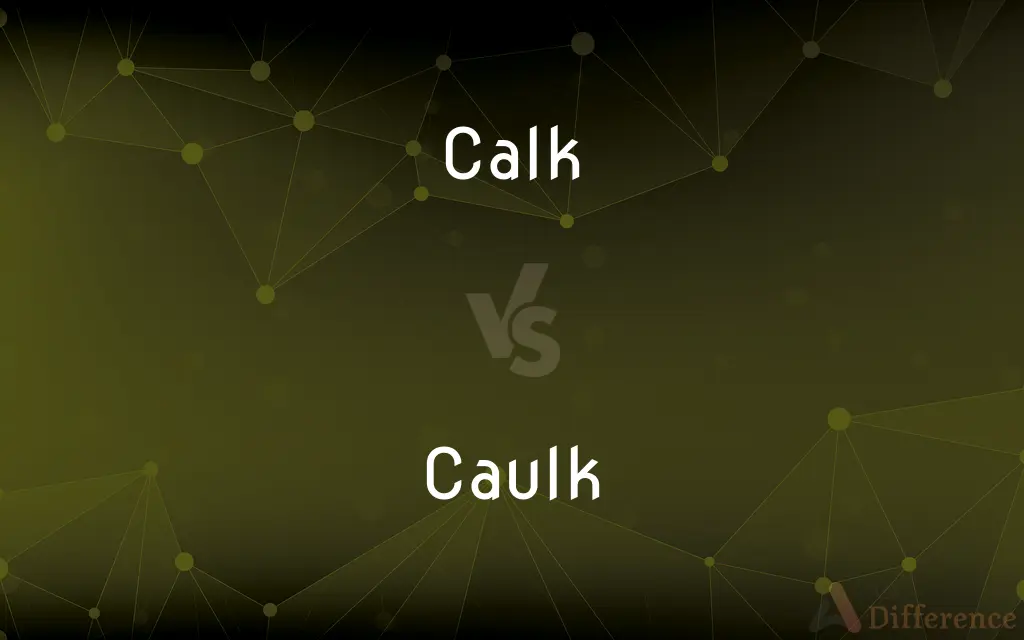Calk vs. Caulk — What's the Difference?
By Tayyaba Rehman — Updated on November 7, 2023
Calk refers to a spike on the shoe for traction; caulk is a sealing compound for filling gaps.

Difference Between Calk and Caulk
Table of Contents
ADVERTISEMENT
Key Differences
Calk is used to increase grip on slippery surfaces, often found on shoes or horseshoes. Caulk is a waterproof filler and sealant used in building and repair work.
Calk has a narrower application, typically related to footwear or horse hooves. Caulk has a broad usage spectrum, from plumbing to construction.
The term calk can be both a noun and a verb related to the act of applying a calk. Caulk, also both a noun and a verb, is associated with sealing joints or seams.
Calk's origin is related to the Old Norse word ‘kalk’, meaning heel or hoof. Caulk derives from the Latin ‘calcare’, to tread, but has evolved in meaning.
Calk often refers to the act of fitting spikes to tires, especially for driving on ice. Caulk relates to the practice of making a joint watertight or airtight.
ADVERTISEMENT
Comparison Chart
Definition
Spikes on shoes for traction
Sealing compound for gaps and seams
Usage
Traction in footwear, horse hooves, tires
Sealing in construction, plumbing, crafts
Form
Both a noun and a verb
Both a noun and a verb
Application
Specific to grip enhancement
Broad in sealing and waterproofing
Etymology
From Old Norse ‘kalk’
From Latin ‘calcare’
Compare with Definitions
Calk
A pointed piece of material on a tool or machine.
The calk on the plow broke after hitting a rock.
Caulk
A waterproof sealant for cracks and joints.
He used caulk to seal the bathtub edges.
Calk
A metal spike on a shoe for traction.
He had to calk his boots before trekking the icy trail.
Caulk
To make watertight by filling in gaps.
We need to caulk the windows before the rains start.
Calk
To fit with sharp points to prevent slipping.
The farrier will calk the horse's shoes for better stability.
Caulk
A flexible material used to seal air gaps in buildings.
The contractor recommended a silicone-based caulk for the exterior joints.
Calk
The act of installing spikes on a tire.
They calk the tires to prepare for the winter roads.
Caulk
To fill or close seams or crevices to prevent leakage.
She caulked the crack in the sidewalk to prevent water seepage.
Calk
A cleat on the bottom of a shoe.
The calks on the climbing shoes dug into the mud.
Caulk
Caulk or (less frequently) caulking is a material used to seal joints or seams against leakage in various structures and piping. The oldest form of caulk consisted of fibrous materials driven into the wedge-shaped seams between boards on wooden boats or ships.
Calk
A pointed extension on the toe or heels of a horseshoe, designed to prevent slipping.
Caulk
To make watertight or airtight by filling or sealing
Caulk a pipe joint.
Caulked the cracks between the boards with mud.
Calk
A spiked plate that is fixed on the bottom of a shoe to prevent slipping and preserve the sole.
Caulk
(Nautical) To make (a boat) watertight by packing seams with a waterproof material, such as oakum or pitch.
Calk
Variant of caulk.
Caulk
To apply caulking
Caulked all around the window frame.
Calk
A pointed projection on a horseshoe to prevent its slipping.
Caulk
Caulking.
Calk
A spike on the sole of a boot to prevent slipping, particularly used in logging
Caulk
Caulking.
Calk
Alternative spelling of caulk
Caulk
A composition of vehicle and pigment used at ambient temperatures for filling/sealing joints or junctures, that remains elastic for an extended period of time after application.
Calk
To make an indentation in the edge of a metal plate, as along a seam in a steam boiler or an iron ship, to force the edge of the upper plate hard against the lower and so fill the crevice.
Caulk
(nautical) To drive oakum into the seams of a ship's wooden deck or hull to make it watertight.
Calk
To copy (a drawing) by rubbing the back of it with red or black chalk, and then passing a blunt stylus or needle over the lines, so as to leave a tracing on the paper or other thing against which it is laid or held.
Caulk
To apply caulking to joints, cracks, or a juncture of different materials.
Calk
To drive tarred oakum into the seams between the planks of (a ship, boat, etc.), to prevent leaking. The calking is completed by smearing the seams with melted pitch.
Caulk
(slang) fuck
Calk
To make an indentation in the edge of a metal plate, as along a seam in a steam boiler or an iron ship, to force the edge of the upper plate hard against the lower and so fill the crevice.
Caulk
To fill in the seams or cracks of, with a waterproof material such as caulk.
Calk
To copy, as a drawing, by rubbing the back of it with red or black chalk, and then passing a blunt style or needle over the lines, so as to leave a tracing on the paper or other thing against which it is laid or held.
Caulk
See Calk.
Calk
To furnish with calks, to prevent slipping on ice; as, to calk the shoes of a horse or an ox.
Caulk
A viscous semisolid material of varying composition used to fill in seams of objects which are exposed to water, such as wooden ships or bath tiles; - called also calk and caulking. After applying in a semisolid form, the material hardens and dries to form a waterproof seal. It is used in the process of caulking. It is sometimes applied together with a rope-like cord to fill larger seams.
Calk
To wound with a calk; as when a horse injures a leg or a foot with a calk on one of the other feet.
Caulk
Seal with caulking;
Caulk the window
Calk
A sharp-pointed piece of iron or steel projecting downward on the shoe of a horse or an ox, to prevent the animal from slipping; - called also calker, calkin.
Caulk
Material used to seal seams in wooden ships.
Caulk was traditionally used to keep wooden vessels seaworthy.
Calk
An instrument with sharp points, worn on the sole of a shoe or boot, to prevent slipping.
Calk
A metal cleat on the bottom front of a horseshoe to prevent slipping
Calk
Provide with calks;
Calk horse shoes
Calk
Seal with caulking;
Caulk the window
Calk
Injure with a calk
Common Curiosities
Can calk be used for car tires?
Yes, calk can refer to studs on tires for additional traction in icy conditions.
Are calk and caulk interchangeable terms?
No, they have different meanings and applications.
How often should you replace caulk?
It depends on the wear and environmental conditions, but generally every 5 years or when it shows signs of deterioration.
Do you need special tools to calk shoes?
Yes, specialized tools are required to apply calks to shoes or horseshoes.
Is caulk waterproof?
Most caulk is designed to be waterproof to seal against moisture.
What types of caulk are there?
There are several types, including silicone, acrylic, and polyurethane caulks.
What is a calk?
A calk is a spike or projection on a shoe sole or a horseshoe to prevent slipping.
What is caulk used for?
Caulk is used to seal joints and gaps to make them watertight or airtight.
How do you apply caulk?
Caulk is applied with a caulking gun, which dispenses the substance into seams and joints.
Is calking a DIY project or should a professional do it?
Depending on the application, it can be a DIY project, but professional fitting is recommended for specialty uses like horseshoes.
Can caulk be painted over?
Yes, but it's best to use paintable caulk for proper adhesion.
How long does it take for caulk to dry?
Drying times vary, but it generally takes 24-48 hours to fully cure.
What are the safety measures when applying caulk?
Use in a well-ventilated area, wear gloves, and follow manufacturer instructions.
Are there different types of calks for different sports?
Yes, different sports utilize various types of calks for the required traction.
Can old caulk be removed?
Yes, old caulk can and should be removed before applying a new layer.
Share Your Discovery

Previous Comparison
Correspond vs. Correlate
Next Comparison
Sellable vs. SaleableAuthor Spotlight
Written by
Tayyaba RehmanTayyaba Rehman is a distinguished writer, currently serving as a primary contributor to askdifference.com. As a researcher in semantics and etymology, Tayyaba's passion for the complexity of languages and their distinctions has found a perfect home on the platform. Tayyaba delves into the intricacies of language, distinguishing between commonly confused words and phrases, thereby providing clarity for readers worldwide.














































